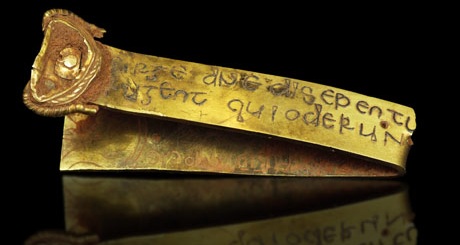
February 9, 2014, by Stephen Mumford
The Past is in the Present; and the Present is in the Past
It’s not just writings, data and bytes of memory that can contain information. I’ve always loved the way that a plain old object, dug up from the ground, can tell a story about the past. The object and the information are in the present, yet they relate to some distant age and give us a view of how people lived, what they did and what thoughts concerned them.
I was lucky to be at our annual Fell-Benedikz lecture given by Leslie Webster on Friday night which was about religious symbols carried into the battlefield in the early 7th Century, mainly based on the Staffordshire Hoard find. We can tell from this that we are far from the first to go into war thinking that God is on our side. And we can also unpick the state of religious belief at the time, partly Christian and partly pagan, though still a matter for discussion and speculation.
Aristotle thought that material objects sought out the ground. He was roughly right: it’s amazing how much we have to dig out of the earth if we want to understand the past. Certainly there are old texts, which tell us a lot, but they always betray one writer’s point of view and preoccupations. Sometimes it’s the old artefacts, bones and relics that tell the honest story and complete the picture. Archaeology is of its essence interdisciplinary, piecing together the facts using a scientific approach in relation to the finds but aided by the texts, paintings and other historical sources that help us understand their significance.
In my student days, I spent a year sharing a house with a former-archaeologist and we often talked about the idea that an old object could contain information. Some philosophers are sceptical about truths concerning the past, pointing out that all such beliefs we hold must be based on information that exists only in the present. There is a verificationist line of reasoning to this, with which I’ve never had sympathy. The evidence is in the now but the past itself isn’t. Information and meaning remain enigmatic notions, however. The thought that a simple object, buried underground for centuries, can arise to tell us its story is fascinating and wonderful: each little mark, scratch or decoration revealing something to the inquisitive eye. And often the lesson is how little we have changed through the millennia. Seeing how we lived then, still helps us to better understand how we live now.
Previous Post
Character and PlotNext Post
Apology for NarcissusNo comments yet, fill out a comment to be the first

Leave a Reply